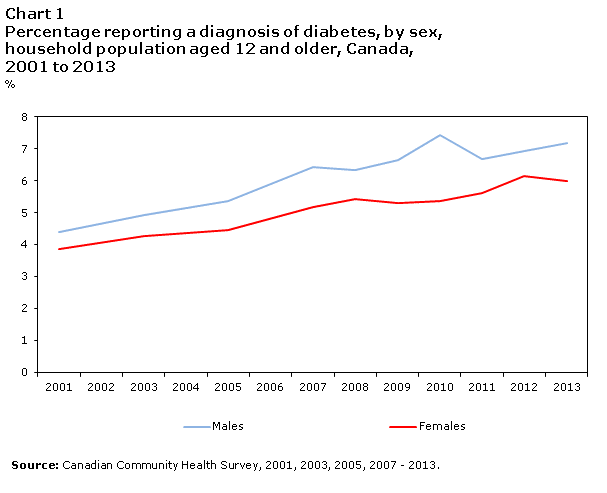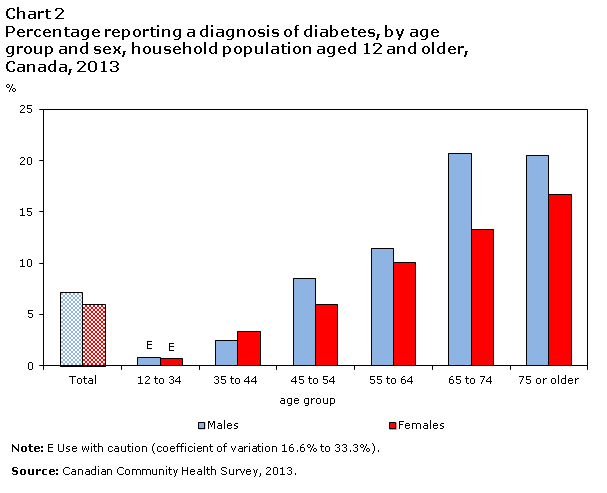Diabetes, 2013
Archived Content
Information identified as archived is provided for reference, research or recordkeeping purposes. It is not subject to the Government of Canada Web Standards and has not been altered or updated since it was archived. Please "contact us" to request a format other than those available.

Diabetes occurs when the body does not produce enough insulin, or when the insulin produced is not used effectively. Diabetes may lead to a reduced quality of life as well as complications such as heart disease, stroke and kidney disease.Note 1
In 2013, 6.6% (2.0 million) of Canadians aged 12 or older reported that they had diabetes. This was not a significant change from 2012, though is an increase from 6.0% in 2009. Survey respondents were asked to report diabetes that had been diagnosed by a health professional. Included in the rates were:
- type 1, which is usually diagnosed in children and adolescents;
- type 2, which usually develops in adulthood; and
- gestational diabetes, which occurs during pregnancy.
Throughout the period from 2001 to 2013, males were more likely than females to report that they had diabetes. In 2013, the rates were 7.2% for males, compared with 6.0% for females (Chart 1).
In addition, Canadians 18 or older who were obese – based on respondent-reported height and weight and Health Canada guidelines on body mass index – were more likely than those who were not obese to report that they had been diagnosed with diabetes. In 2013, 15.3% of obese Canadians 18 or older had diabetes, compared with 5.1% of those who were not obese.

The rate of diabetes for males increased with age starting at 12 and up to age 65. There was no significant difference between males aged 65 to 74 and those 75 or older. For females, the rate increased with age across all age groups (Chart 2).
In most age groups, males and females had roughly the same rates of diabetes. Between the ages of 45 and 54 and after 65, males were more likely than females to be diabetic (Chart 2).

The proportion of residents who reported being diagnosed with diabetes was lower than the national average (6.6%) in:
- Alberta (5.3%)
- British Columbia (5.5%)
The proportion of residents who reported being diagnosed with diabetes was higher than the national average in:
- Newfoundland and Labrador (8.6%)
- Prince Edward Island (8.9%)
Residents of the other provinces and territoriesNote 2 reported rates that were about the same as the national average.
Because diabetes is strongly related to age, provinces and territories with disproportionately younger populations are expected to have lower diabetes rates than the national average. The reverse is true for provinces and territories with older populations. To remove the effect of different age distributions when making provincial comparisons, please refer to the CANSIM table 105-0503 for the age standardized rates.
End notes
References
James, Robert, T. Kue Young, Cameron A. Mustard and Jamie Blanchard. 1998. “The health of Canadians with diabetes.” Health Reports. Vol. 9, no. 3. Winter. Statistics Canada Catalogue no. 82‑003. p. 47–52. http://www.statcan.gc.ca/studies-etudes/82-003/archive/1997/3477-eng.pdf (accessed May 10, 2010).
Millar, Wayne, J., and T. Kue Young. 2003. “Tracking diabetes: Prevalence, incidence and risk factors.” Health Reports. Vol. 14, no. 3. May. Statistics Canada Catalogue no. 82-003. p. 35–47. http://www.statcan.gc.ca/studies-etudes/82-003/archive/2003/6599-eng.pdf (accessed May 10, 2010).
Ng, Edward, McGrail, Kimberlyn M., Johnson, Jeffrey A. 2010. “Hospitalization risk in a type 2 diabetes cohort.” Health Reports. Vol. 21, no. 3. Statistics Canada Catalogue no. 82-003. p. 1-7. http://www.statcan.gc.ca/pub/82-003-x/2010003/article/11326-eng.pdf (accessed April 7, 2011).
Ross, Nancy A, Gilmour, Heather, Dasgupta, Kaberi. 2010. “14-year diabetes incidence: The role of socio-economic status.” Health Reports. Vol. 21, no. 3. Statistics Canada Catalogue no. 82-003. p. 19‑28. http://www.statcan.gc.ca/pub/82-003-x/2010003/article/11325-eng.pdf (accessed April 7, 2011).
Data
Additional data from the Canadian Community Health Survey are available from CANSIM tables 105–0501 and 105-0503.
- Date modified:
